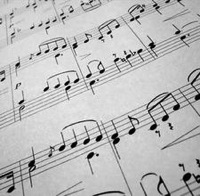Difference between revisions of "Chord"
(Created page with 'File:lighterstill.jpgright|frame ==Origin== Originally ''cord'' , aphetic form of accord *[http://en.wikipedia.org/wiki/17th_century 1608]...') |
m (Text replacement - "http://" to "https://") |
||
| Line 3: | Line 3: | ||
==Origin== | ==Origin== | ||
Originally ''cord'' , aphetic form of [[accord]] | Originally ''cord'' , aphetic form of [[accord]] | ||
| − | *[ | + | *[https://en.wikipedia.org/wiki/17th_century 1608] |
==Definitions== | ==Definitions== | ||
* three or more [[musical]] [[tones]] sounded [[simultaneously]] | * three or more [[musical]] [[tones]] sounded [[simultaneously]] | ||
==Description== | ==Description== | ||
| − | A '''chord''' in [[music]] is any [[harmonic]] set of two–three or more notes that is heard as if sounding simultaneously. These need not actually be [[played]] [[together]]: [ | + | A '''chord''' in [[music]] is any [[harmonic]] set of two–three or more notes that is heard as if sounding simultaneously. These need not actually be [[played]] [[together]]: [https://en.wikipedia.org/wiki/Arpeggio arpeggios] and broken chords may for many [[practical]] and [[theoretical]] [[purposes]] be [[understood]] as chords. Chords and [https://en.wikipedia.org/wiki/Chord_progression sequences of chords] are frequently used in modern western, west African and Oceanian music, whereas they are absent from the music of many other parts of the world. |
| − | The most frequently encountered chords are [ | + | The most frequently encountered chords are [https://en.wikipedia.org/wiki/Triad_(music) triads], so called because they consist of [[three]] distinct [[notes]]: further notes may be added to give [https://en.wikipedia.org/wiki/Seventh_chord seventh chords], [https://en.wikipedia.org/wiki/Extended_chord extended chords], or [https://en.wikipedia.org/wiki/Added_tone_chords added tone chords]. The most common chords are the [https://en.wikipedia.org/wiki/Major_chord major] and [https://en.wikipedia.org/wiki/Minor_chord minor] triads and then the [https://en.wikipedia.org/wiki/Augmented_triad augmented] and [https://en.wikipedia.org/wiki/Diminished_chord diminished] triads. The descriptions "major", "minor", "augmented" and "diminished" are sometimes referred to [[collectively]] as chordal "quality". Chords are also commonly classed by their root note so, for instance, the chord C Major may be described as a triad of major quality built upon the note C. Chords may also be classified by [https://en.wikipedia.org/wiki/Inversion_(music) inversion], the order in which their [[notes]] are stacked. |
| − | However, since the structural [[meaning]] of a chord depends exclusively upon the [ | + | However, since the structural [[meaning]] of a chord depends exclusively upon the [https://en.wikipedia.org/wiki/Scale_degree degree of the scale] upon which it is built, chords are usually analysed by numbering them, using [https://en.wikipedia.org/wiki/Roman_numerals Roman numerals], upwards from the key-note (See [https://en.wikipedia.org/wiki/Diatonic_function diatonic function]). There are four common ways of [https://en.wikipedia.org/wiki/Chord_(music)#Notation notating or representing chords] in western music other than conventional staff notation; Roman numerals, figured bass, much used in the [https://en.wikipedia.org/wiki/Baroque_music Baroque era], [https://en.wikipedia.org/wiki/Macro_analysis macro symbols], sometimes used in modern musicology, and various systems of [[symbols]] and notations such as are typically found in the lead sheets, fake books and chord charts used in [https://en.wikipedia.org/wiki/Chord_names_and_symbols_(jazz_and_pop_music) jazz and popular music] to lay out the harmonic groundplan of a piece so that the musician may [[improvise]] a part.[https://en.wikipedia.org/wiki/Chord_%28music%29] |
[[Category: Music]] | [[Category: Music]] | ||
Latest revision as of 23:41, 12 December 2020
Origin
Originally cord , aphetic form of accord
Definitions
- three or more musical tones sounded simultaneously
Description
A chord in music is any harmonic set of two–three or more notes that is heard as if sounding simultaneously. These need not actually be played together: arpeggios and broken chords may for many practical and theoretical purposes be understood as chords. Chords and sequences of chords are frequently used in modern western, west African and Oceanian music, whereas they are absent from the music of many other parts of the world.
The most frequently encountered chords are triads, so called because they consist of three distinct notes: further notes may be added to give seventh chords, extended chords, or added tone chords. The most common chords are the major and minor triads and then the augmented and diminished triads. The descriptions "major", "minor", "augmented" and "diminished" are sometimes referred to collectively as chordal "quality". Chords are also commonly classed by their root note so, for instance, the chord C Major may be described as a triad of major quality built upon the note C. Chords may also be classified by inversion, the order in which their notes are stacked.
However, since the structural meaning of a chord depends exclusively upon the degree of the scale upon which it is built, chords are usually analysed by numbering them, using Roman numerals, upwards from the key-note (See diatonic function). There are four common ways of notating or representing chords in western music other than conventional staff notation; Roman numerals, figured bass, much used in the Baroque era, macro symbols, sometimes used in modern musicology, and various systems of symbols and notations such as are typically found in the lead sheets, fake books and chord charts used in jazz and popular music to lay out the harmonic groundplan of a piece so that the musician may improvise a part.[1]
